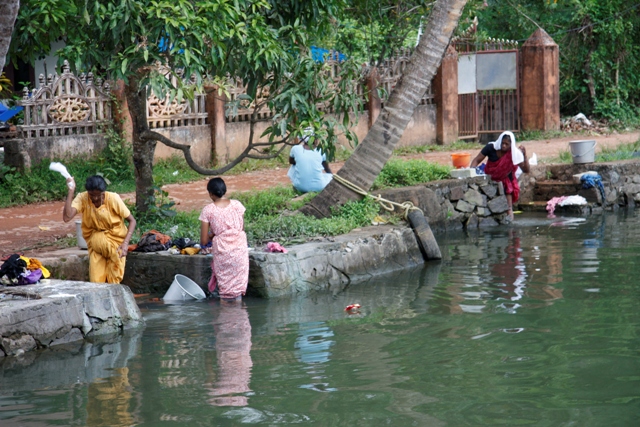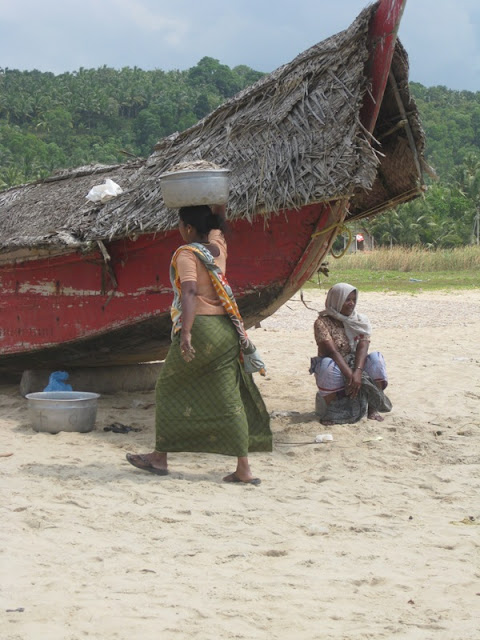It was only about 140 km from Kumarakom, but 5 hours later we arrived at Munnar, in the heart of tea country. The Tea County Resort was very comfortable but the succession of curries on the buffet menu at night a bit hard to take - fortunately there was enough to choose from the menu.
Part 3, Tea country in the Western Ghats.
Munnar is a relatively small town at an altitude of around 1,800m (6,000 feet) and quite cool and much drier than the coast of course.
 |
| Munnar |
It was the middle of November when we were here, there was plenty of cloud and heavy rain showers. The monsoon had eased off but was still lingering around in Tamil Nadu on the other side of the Western Ghats.
 |
| Local market |
Travelling in India is easy to organise. Make sure you arrange a transfer from the airport to your first hotel, or you can haggle with the multitude of drivers outside the arrivals hall. The hotels can arrange a driver to show you all the sites and transfer you to your next destination if it is not too far away. We had the same driver at Munnar for three days including the trip down to Kochin. Prices are quite reasonable and seem to be set by the local government and advertised at the local bus/ taxi station.
Heading out of Munnar towards Top Station (shrouded in clouds unfortunately) we passed through the tea plantations and several "tourist spots"
 |
| Camellia sinensis - the tea bush |
 |
| Tea plantation |
 |
| Tea picking in progress. |
The green shoots are harvested every 10 - 20 days by armies of women working the steep hillsides. The fresh shoots are sometimes plucked by hand but now most of the harvest is now done using shears like you would cut a hedge with.
 |
| A cheerful estate worker who posed obligingly. |
 |
| Another hard at work. |
These women have to pick / cut 25 kg of leaf per day in order to get a pay of 120 rupees. This is equivalent to around $NZD3.40! Slave labour you might think - if they got a decent wage, we would all complain about the price of tea! However the tea companies, like Tata do provide free housing, health care and I think the fruit and vegies grown nearby are supplied free of charge. We were taken to one housing estate where everyone seemed very happy with their lot - probably because they knew no better.
 |
| Front doors to row of around 6 houses. |
 |
| Running water and the "sink" to wash the dishes, using charcoal to clean the pots. |
 |
| A westerner in the kitchen! |
 |
| A dam "tourist spot" |
On the way back down to Munnar the driver stops at a couple of dams. The locals flock there to sample the delights of various fruits, spices, drinks and the tackiest souvenirs you could wish for! Needless to say we didn't buy anything as we had a full time job watching where each foot was placed in amongst ..... well everything that would go in a rubbish bin or down a toilet; which were conspicuously absent.
 |
| Munnar schools boys parading their trophy. What is for I have no idea. |
 |
| A traditional face painting job and head gear. |
 |
| Facial gestures mean something as well as the hand positions. |
After 3 nights in Munnar it was time to move on to Kochin. We only had a few hours there but checked into the Reds Residency Homestay for a few hours, 750 rupees - cheap but very nice.
Kochin was and maybe still is an important port city. It has been variously occupied or controlled by the Portuguese followed by the Dutch, who built the fort and then the English who eased them out until independence.
 |
| St Francis Church, Kochin |
Vasco de Gama was buried in the church yard here in 1524 but his mortal remains were exhumbed and transferred to Portugal in 1539.
(Canon 450D, EF-S 10-22mm lens at 10mm. f/4, 1/40s, ISO-200.
0 exposure bias.)
As the sun set on this day it was time to head back for a short sleep before heading to the airport just after midnight to catch the plane back to Abu Dhabi.
Where to next? Wait and see. There are 2 weeks holiday starting on 17 December.
 |
| Kochin rainbow |
0 exposure bias.)
 |
| Kochin sunset |
(Canon 450D, EF-S 17-85mm lens at 61mm. f/5.6, 1/15s, ISO-800. -1⅔ exposure bias. For sunset photos, play with the exposure bias down to -2 f stops, the results are amazing. For this one I rested the camera on a rail to help improve the sharpness even though the image stabilization was on. A good result I think.)
As the sun set on this day it was time to head back for a short sleep before heading to the airport just after midnight to catch the plane back to Abu Dhabi.
Where to next? Wait and see. There are 2 weeks holiday starting on 17 December.
































